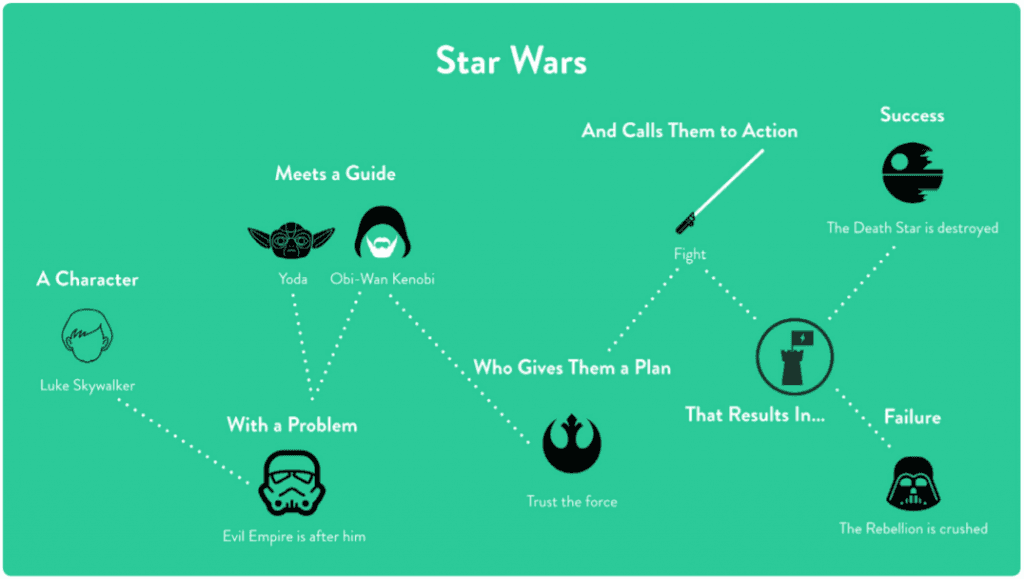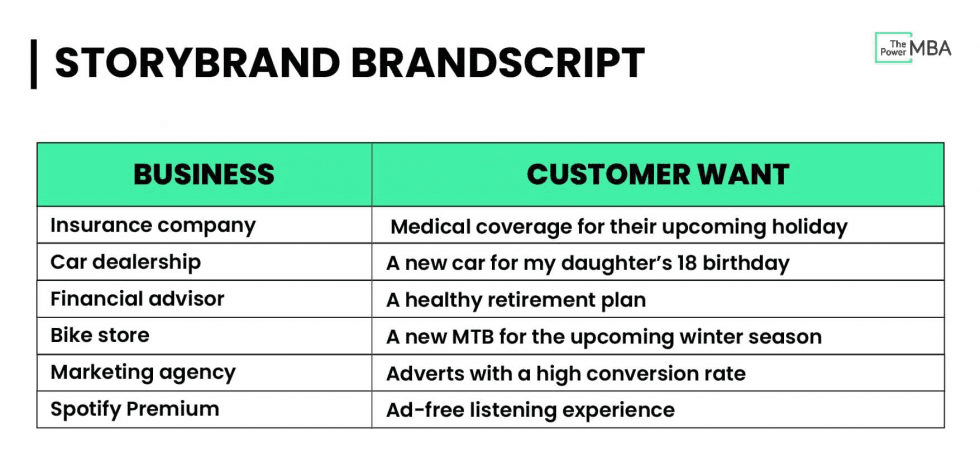StoryBrand Brandscript: Donald Miller’s 7-Part Framework

Franco Brutti
Donald Miller was on a flight to a conference in Indianapolis when the StoryBrand Brandscript idea hit him.
The successful author often held conferences about his career as a writer, his faith, and how people could live a fulfilling story throughout their lives.
But in Portland, as was the case in many other cities he’d visited, he left feeling disappointed. While having 350 conference attendees was certainly nothing to be ashamed of, the auditorium had space for over 700. That meant he’d only managed to fill to half capacity.
Week after week looking at rows of empty seats started to take its toll.
However, that was all about to change.
Back to that flight to Indianapolis, Miller in fact found himself sitting next to a guy reading his book. Imagine the odds? It was a surreal moment for Miller - genuinely the first time he’d seen one of his books in the “wild”.
So jokingly, he asked the guy, what he thought of the book?
He replied “yeah, in fact, it’s the third time I’ve read it. I’m actually going to see him in a conference tonight in Indianapolis…”
This is when it dawned on Miller he had a golden opportunity here; two hours to get feedback from an unbeknown customer about his perception of the Storyline brand (Miller’s conference company at the time).
And he was completely taken aback at what he found.
While the guy was clearly impressed, he really didn’t have the words to succinctly communicate why anybody should be interested in the brand.
Yes, the feedback was positive, but it was also a mish-mash of different messages. Not one convinced Miller to go out and buy the book or attend his conference.
This, of course, was worrying.
So he took ownership of the problem. He knew something had to be done about clarifying his branding and marketing message.
And he had just the idea of how…storytelling.
What Does Storytelling Have to Do With Branding?
You might be wondering, what on earth storytelling has to do with your branding and marketing communication?
Just bear with me a second, as Miller really was on to something.
He’d frequently written about storytelling in his own work and understood its power in captivating the human brain.
That’s because stories use a “sense-making mechanism”. The plot is almost always laid out in chronological order and is easy for the viewer/reader to follow.
Why is this important for marketers?
As Miller explains in his book, Building a Storybrand, the primary role of the brain is to help you survive. To that end, we’re constantly scanning our environment for useful information; to find love, seek inspiration, affection, acceptance, either spiritual, physical, or emotional.
All great stories (and their heroes) pursue and endeavor to achieve one, or if not more, of these “survival” traits.
So, if visitors come to your website and can’t quickly deduce how you can help them survive, they’ll leave. The human brain is simply designed to tune you out.
This is why it’s not the best product that’s always successful, but the company with the clearest branding and the best story.
How do you develop a story within your brand’s communication and get customers to pay attention to what you’re saying?
Well, there’s a framework for that too.
The StoryBrand Brandscript Framework
When searching for a framework for StoryBrand Brandscript, Miller noticed that all engaging movies (regardless of genre or era) tended to follow a similar, clear, almost formulaic framework.
It was the same for Star Wars and Lord of the Rings, as it was for Hunger Games and the latest James Bond movie.
The movies he could not engage with diverted from this structured path.
For example, when it wasn’t clear how the hero was going to win the day. What were the internal/external struggles they had to overcome? When there was no guide figure to help them on this path, etc.
After careful thinking, he concluded there are 7 key elements to almost every successful story:
#1 There’s a protagonist or character who wants something.
#2 This character encounters a problem in the way of getting what they want.
#3 A guide appears who is able to help them overcome this problem.
#4 They do so by giving them a plan of action.
#5 Which calls them to action.
#6 The subsequent action helps them avoid failure.
#7 And achieve success.
I’ll show you what he means…
Let’s take the Star Wars saga for example.

(Source: StoryBrand)
The saga’s protagonist, Luke Skywalker, is at war with the Galactic Empire, led by his father the Sith Lord, Darth Vader.
In his quest to overcome the Empire, he receives training and guidance from Obi-Wan Kenobi and Master Yoda. Their plan is to train him as a Jedi Knight, to trust in the force, and to do battle with the Empire.
If he’s unsuccessful in his quest, the rebellion will be crushed, and the dark side of the force will prevail. Not good.
But with his training, guidance, and sheer willpower - he’s able to prevail and destroy the Death Star.
The end.
It’s highly unlikely your brand needs to destroy a Death Star to sell products. However, that doesn’t mean you can’t filter your brand messaging through the same framework.
“Doing so helps identify aspects customers look for in their story as it relates to your brand.”
To break it down so that it makes sense for brands, Miller constructed his 7-point StoryBrand Brandscript:

(Source: StoryBrand)
The framework helps companies:
#1 Frame customers as the lead character in their story, and clearly identify what they want.
#2 Understand the challenges they face and how the company’s product/service is a solution.
#3 Position themselves as the customer’s guide by demonstrating empathy and authority.
#4 Develop a clear plan for customers to follow leading them to purchase a product/service.
#5 Promote a CTA (call to action) that encourages customers to take action.
#6 Clearly demonstrate to customers what success and failure look like if they purchase/don’t purchase the product/service.
Once the messaging is clarified for each of these story elements, companies can apply this language to their branding and marketing communications.
It can be used in web copy, landing pages, sales and nurturing emails, ad copy, eBooks, elevator pitches, keynote speeches, etc. Anywhere the product or service is being sold.
Still a little unsure of how it works?
Let me break down each of the seven elements (with examples) to give you a clearer idea.
Character (Hero)
Every human being self-identifies as the hero of the story. You’ve likely found yourself fulfilling the role at some point, sitting through Lord Of The Rings, James Bond, or any “heroic” or entrepreneur movie of your choice.
It feels good watching the hero overcome certain challenges to reach their goal, as it’s not so dissimilar to our own lives. We can put ourselves in their shoes.
OK, we might not be destroying Death Stars, but we all have aspirations and long-term goals we want to achieve.
Now, the biggest mistake brands make is playing the hero.
If you spend too much time telling your story, customers will disengage. They don’t want to hear about you. They are the protagonists, remember? Looking for a guide to their own story.
“The customer is always the hero and you, the company, are the guide.”
While it’s nice to hear about how far back your family business goes, all customers are thinking is…
“That’s great, you’re a hero too...but what about me?”
So let’s write their story.
First of all, brands need to identify what customers want in relation to their products.
Let’s look at a few examples:

Secondly, brands need to figure out what customers want to be. What’s the inspirational or aspirational identity associated with using your product or service?
For Tesla customers, that could be the aspirational identity of an “innovator” or “new-age thinker”.

Or for Ford 150 users it could be “ruggedness” or “outdoorsmen”.
https://www.youtube.com/watch?v=B3MG7ZcIH5k&feature=emb_logo
Clarifying these two customer “wants” helps for two reasons.
Firstly, it keeps the story clear; a common mistake companies make is overwhelming customers with hundreds of messages.
Secondly, it creates a story gap. In order for customers to achieve this want, that gap will need to be fulfilled by purchasing a product or service.
Problem
Now it wouldn’t be much of a story if there wasn’t some kind of challenge involved now, would it?
Miller suggests that in business, just like the movies, there are 3 different types of problems a character faces:
EXTERNAL
INTERNAL
PHILOSOPHICAL
External
The external problem is often portrayed as a physical barrier that the hero must overcome to circumnavigate to achieve their goal. Think of Frodo’s long, arduous journey to Mordor in Lord of The Rings or John McClane’s mission to neutralize the terrorist threat at the Nakatomi Plaza in Die Hard.
In business, it’s typically easy to identify the external problem a company solves.
For example, an extractor fan removes moisture and odors from a kitchen or bathroom, a car dealership sells cars, and a drinks bottle stores water or liquids so that they can be easily transported.
Whatever the problem, it needs to be clearly stated in all marketing communications.
Internal
Now an external problem is not enough to engage an audience on its own. It needs help.
Viewers can’t identify or sympathize with McClane in Die Hard if the story was just about him neutralizing a terrorist cell. They need it to manifest into an internal problem they can relate to.
So, when McClane’s external problem poses a risk to his wife’s safety, for example, the audience can relate. They can understand McClane’s fear of losing a loved one, even though they’ve never tried to take on a 10-man terrorist cell.
It’s the same in business.
Companies should discuss how their products solve an internal problem. This is how customers are really going to buy into the brand.
Going back to Tesla, an external problem their customers face is needing a new car.
However, they could go to any dealership or car manufacturer for that. So, why choose Tesla?
Because they address an internal problem customers face; wanting to be early adopters of new technology.
Now, there’s just one final twist to the tale...
Philosophical
The final type of problem characters and customers alike face is the philosophical problem.
In movies, this is the larger context in which the story itself plays out. For example, in the King’s Speech, George VI faces an external problem of stuttering when delivering public speeches. This manifests into an internal problem of lack of confidence and embarrassment.
However, the whole story is played to the backdrop of a much larger, philosophical problem - uniting the nation to battle the Nazi regime.
Can you guess what the philosophical problem might be for Tesla’s customers?
If you guessed the idea that their car should, in some way, run with reduced emissions and help save the planet - then you were 100% right!
By addressing all 3 problems in their branding and marketing communications, companies invite customers to partake at a much deeper level in the story.

Guide
Every hero has a guide to help them on their journey. Luke Skywalker had Obi-Wan Kenobi, Harry Potter had Professor Dumbledore, and Daniel had Mr. Miyagi.
Why is it important for our heroes to have a guide?
Because if they don’t need a guide then the problem itself isn’t very difficult to solve. And that wouldn’t make for a very interesting story now, would it?
You might remember that at the start of the post I made it clear that:
“The customer is always the hero and you, the company, are the guide.”
Your job is to show customers the path and help them reach their overall goals.
Now to do so, brands must demonstrate empathy with their customer’s situation and authority to show they know what they’re doing.
Expressing Empathy
This is easily achieved by addressing a customer’s internal problem. Show them that you understand what they’re going through, what they’re feeling.
Let’s take a look at a couple of examples.
The cosmetic brand Lush does a great job of this. They identified their customer’s internal problem as using naturally sourced products.
So, to demonstrate empathy with their situation they created a series of “How It’s Made” videos to prove their authenticity:
Another company to look at is Nike (of course...). Their customers face the external problem of needing clothing/equipment to get active.
However, they face an internal challenge of self-doubt about their ability to do so. Am I good enough? But, I’m not in great shape? What will people think of me?
Their iconic slogan Just Do It captivates this feeling perfectly. It also demonstrates how anybody can overcome the “impossible” and achieve success.
This is perhaps never been better framed than in their #Breaking2 campaign.
Demonstrating Authority
This is all about showing customers that you’ve already guided and delivered other like-minded individuals to their goals.
The best way to do this via testimonials and customer success stories.
In our case at #ThePowerMBA, we want to demonstrate to potential students that we have a proven track record of helping people reach their professional goals.

Plan
In movies, the guide puts a clear plan in place for the hero. It gives the movie focus and direction but more importantly, makes it easy for the audience to follow.
Think back to Lord of The Rings.
Frodo and The Fellowship must destroy the One Ring. To do so, it physically needs to be taken and cast into the fires of Mount Doom. The guiding figure, Gandalf The Grey, maps out a clear route and helps them overcome their challenges along the journey.
Businesses must do the same for their customers.
Now they know what it is they want, plus the internal, external, and philosophical problems they face, it’s time to give them a plan.
Show them what they need to do to achieve their goal. Essentially, this stage is about clarifying how a customer does business with you.
To keep things simple, Millers suggests breaking it down into 3 chronological steps. Remember, this helps structure the storytelling narrative in the customer’s mind.
For example, your sign-up page might look something like this:
Schedule a call
Walkthrough ThePowerMBA curriculum
Find the perfect program to match your professional goals
While it might seem obvious to you, it gives customers a clear picture of what they need to do.
Here’s another example from Fusion Designed:

Again, the customer path is clear, easy to follow, and provides them with a plan of action.
Call Them to Action
Now that our hero understands what must be done to achieve their goals, it’s time to take action.
Typically in a movie, there’s a “trigger moment” - something that forces our hero into action.
In Lord of The Rings it was the prospect of Middle Earth being destroyed, in The Matrix it’s the imminent arrival of the machines, and Die Hard the potential robbery of $640m in bearer bonds.
Again, your customers probably aren’t motivated by imminent doom to take action. However, they will need something to nudge them in the right direction.
In marketing, this is represented by a clear CTA (call to action) button somewhere on the page. Something that jumps out and catches their attention.
Miller suggests having two types of CTA:
Direct (buy our product now)
Transitional (learn more)
Direct CTAs are a clear invitation for customers to do business (sign-up for a service, place a product order, membership enrollment, etc.)
Transitional CTAs put customers at less immediate risk. It’s still a clear next step on their journey, but more of a new chapter, rather than the grand finale.
Here at ThePowerMBA, we use a mixture of both. Here you’ll see a direct CTA for students ready to join our enrollment waiting list:

Whereas in this case, we offer students more information in the form of a downloadable PDF file (a transitional CTA).
This way students can come back and revisit the information at a time of their choosing.
Avoid Failure
What makes a story so engaging is the audience understands that the hero could fall at any moment. We’re constantly asking ourselves:
“What’s at stake for the hero?”
If there’s nothing at stake, then why should the audience care what happens to the protagonist?
Companies must do the same with their clients. They need to show them in their marketing communications the consequences of their inaction.
In his book, Miller argues customers are more motivated by loss aversion than they are to gain.
That is to say the fear of losing something forces people to act more than their potential to gain.
Let’s look at how Bank of America uses it on their retirement plan page:

Notice how they address what would happen if customers fail to invest in a retirement plan?
How are you going to afford healthcare?
How are you going to save enough money?
Will you be able to manage debt?
Fear of loss or failure is a powerful motivator for taking action.
Success
A great story always tied off with a neat bow and a happily ever after ending. If not, viewers leave feeling dissatisfied…
“I mean, why did I just sit through that movie for the hero to fail anyway?”
To this end, companies need to make it crystal clear what a customer’s happy ending looks and feels like.
For example, if you’re buying an expensive sports car you want to feel powerful and prestigious. Companies need to show you that’s what will happen if you buy their car.
Whatever that positive outcome is as it pertains to your product or service, it needs to be clear to customers.
Create Your StoryBrand Brandscript
Now it’s time to pull it all together. After reviewing the 7-part framework and jotting down ideas for your brand story, try to condense them into your own Brandscript.
This will form the foundation for all your future marketing communications.
Try using the following template to create your StoryBrand Brandscript:
“At (COMPANY NAME) we know that you want to be (a/an) (IDENTITY
TRANSFORMATION). In order to do that, you need (CHARACTER
WANT). The problem is (EXTERNAL PROBLEM) which makes you feel
(INTERNAL PROBLEM). We believe (PHILOSOPHICAL PROBLEM).
We understand (EMPATHY) which is why we (AUTHORITY). Here’s how
we do it: 1 (PLAN: STEP 1). 2 (PLAN: STEP 2). 3 (PLAN: STEP 3). So,
(DIRECT CTA). And in the meantime, (TRANSITIONAL CTA). So you
can stop (FAILURE) and instead (SUCCESS).”
Looking for something specific?






